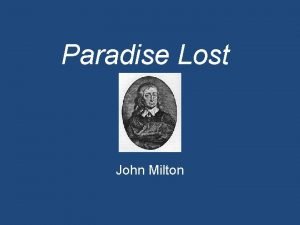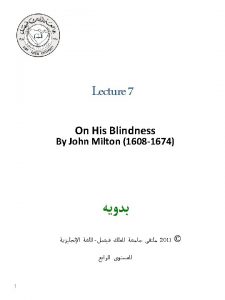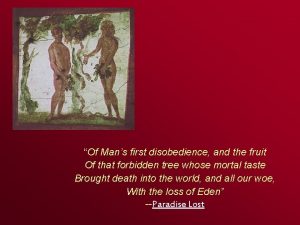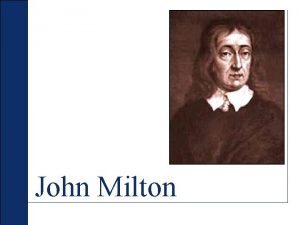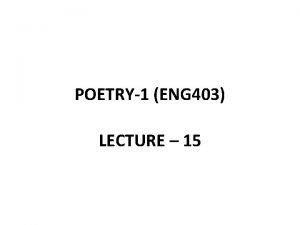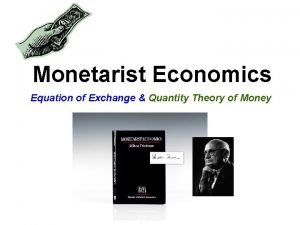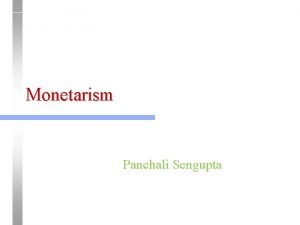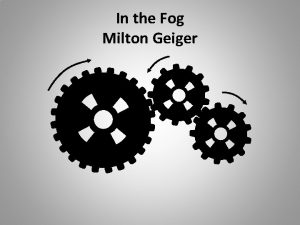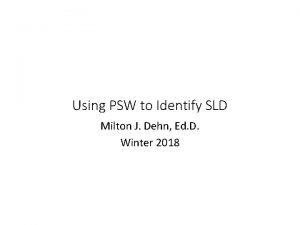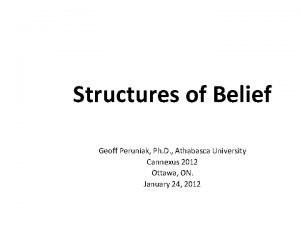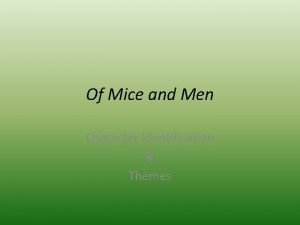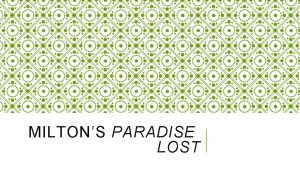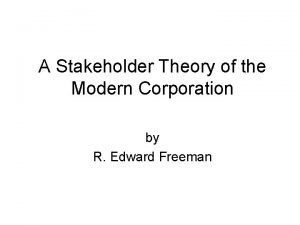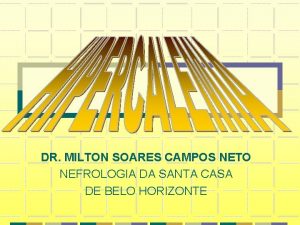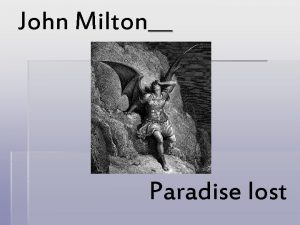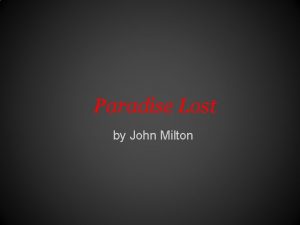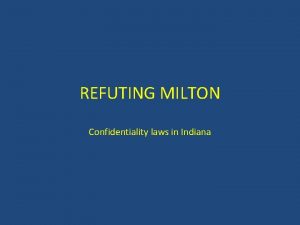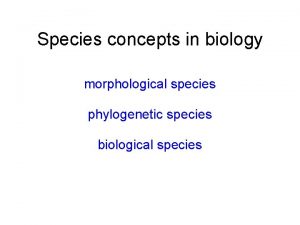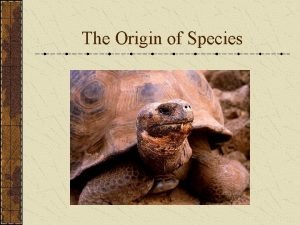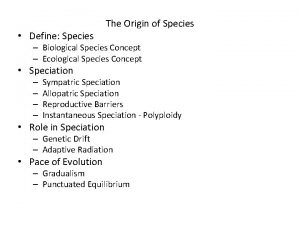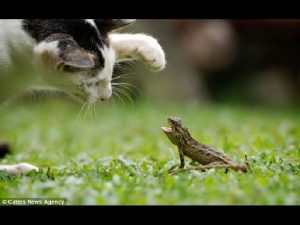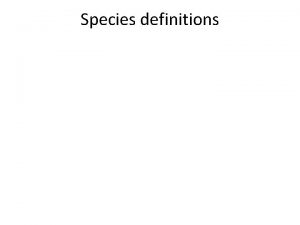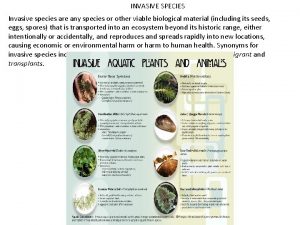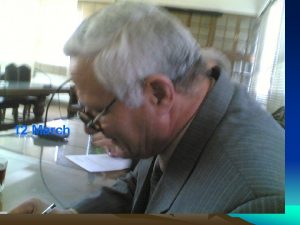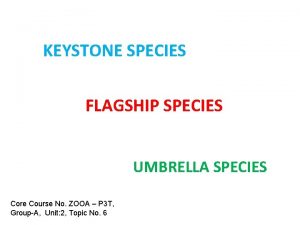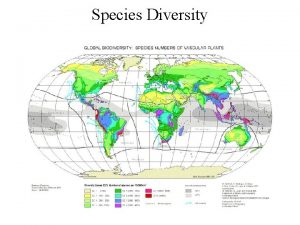SPECIES CONCEPTS Dr M C John Milton PG





































- Slides: 37

SPECIES CONCEPTS Dr. M. C. John Milton PG & Research Department of Advanced Zoology and Biotechnology Loyola College (Autonomous), Chennai 600 034 drjohnmilton@gmail. com drmilton@loyolacollege. edu 1

Species concept q Cuvier (1829) assemblage descended from common parents q Darwin (1859) could not define q Thompson (1937) individuals distinguished by irreducible properties and connected by descent and genetic relationship. q Dobszhansky (1937) single systematic category withstood all changes in nomenclature q Huxley (1942) geographically definable group, interbreed, fertile with related groups q Zimmermann (1948) species are considered similar on superficial observation q Borgmeier (1963) species as natural phenomenon and biological unit based on objective facts. 2

Typological species concept q Diversity of universe is because of limited number of ‘Univesals’ q If 2 individuals are sufficiently different they are different species q Variation is irrelevant q Essentialism – species can be recognised by their essential characters q Colour, size, habitat etc. , (morphological species concept) 3


criticism q Sexual dimorphism, age difference, polymorphism and other forms of individual variation –no use for caterpillar and butterfly classification q It is helpless in sibling species – good genetic species but lack conspicuous morphological differences 5

Nominalistic species concept q q Popular in France in 18 th century - Occam Nature produces individuals nothing more Species are man made and mental concepts Species have no actual existence in nature it is to refer great numbers collectively. 6


criticism q Species are products of evolution not man made q Misinterprets similarity and relationship q Members of species are similar because of common heritage they are nor called species because they are similar 8

Biological species concept q q q Introduced by Mayr 1750 Species has three separate functions Reproductive community Ecological unit Genetic unit 9



Problems of biological species concept q q q Apomictic or asexual groups Sibling and cryptic species Gradual speciation Rings of races Hybrid complexes 12

Evolutionary species concept q It is applicable to apomictic and fossil lineages q Species is a single lineage of ancestral descendant population of oranisms which maintains its own evolutionary tendencies and historical fate 13





Recognition species concept q Species is the most inclusive population of individual biparental organisms which share a common fertilization system. q Fertilization includes all aspects of an organisms biology q Organisms recognise each other as mates or passive q This doesn’t include barriers to gene flow after fertilization – hybrid sterility, inviability 18















Kinds of species q Sibling species : closely related, morphologically identical but reproductively isolated. q Sympatric species : occupying same geographical area q Allopatric species : inhabit completely different geographical areas. q Continental Species : living on large land masses. q Insular species : living on isolated islands owe their fauna to dispersal methods. q Tropicopolitan or pantropical species : found throughout tropics 33

q Montane species : occur at high elevations. q Morphogeographical species : known from Linnaean times to present q Agamospecies : consists of uniparental organisms – reproduce parthenogenitically. q Panmictic species : species in which each sex is produced by diff. individual (dioecious) or species in which 2 sexes are produced by same individual (Monoecious) 34

q Apomictic species : no mixing of gametes between different individuals – unisexual- producing ova others reproduce completely by budding or fission. q Parapatric species : whose ranges are adjacent due to competition. q Contemporaneous species : occur at same time level. They indicate number of lines or lineages occuring at any particular time. 35

q Polytypic species : consist 2 or more subspecies q Monotypic species : no sub species q paleontological species : fossils q Philapatric species : do not show any tendency to extend their range. q Incipient species : geographical subspecies which become isolated will be distinct 36

q Morphospecies : morphological similarity regardless of other considerations. q Form species : fossil objects not identifiable 37
 John milton drama
John milton drama John milton themes
John milton themes On his blindness by john milton
On his blindness by john milton Of man's first disobedience and the fruit
Of man's first disobedience and the fruit Dr john milton
Dr john milton John milton early life
John milton early life When did milton go blind
When did milton go blind Paradise lost date
Paradise lost date The fall of satan paradise lost
The fall of satan paradise lost Political background of puritan age
Political background of puritan age On the late massacre in piedmont
On the late massacre in piedmont Consider how
Consider how Keystone plant
Keystone plant Don alden adams
Don alden adams Milton web
Milton web Bottle banks milton keynes
Bottle banks milton keynes Teori milton friedman
Teori milton friedman Danny elfman oliver elfman
Danny elfman oliver elfman M.v=p.y
M.v=p.y Monetarism
Monetarism Dr. badawi milton
Dr. badawi milton Apelido do milton nascimento
Apelido do milton nascimento Milton olive middle school
Milton olive middle school Population of milton keynes
Population of milton keynes Poetry essay on london 1802
Poetry essay on london 1802 Ghosts in the fog summary
Ghosts in the fog summary Milton dehn
Milton dehn Biographical approach in literature
Biographical approach in literature Milton rokeach
Milton rokeach Of mice and men character personality traits
Of mice and men character personality traits Paradise lost lecture
Paradise lost lecture Born june 26
Born june 26 Milton catelin
Milton catelin Freeman and friedman
Freeman and friedman National mattress milton
National mattress milton Teori milton friedman
Teori milton friedman Ruth milton public health england
Ruth milton public health england Milton soares campos neto
Milton soares campos neto

